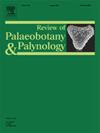陡峭的气候梯度对两个石炭纪-二叠纪冰期片中特提斯海岸阿拉伯部分孢粉组合的影响
IF 1.7
3区 地球科学
Q2 PALEONTOLOGY
引用次数: 0
摘要
Serpukhovian—Bashkirian(石炭世)和Gzhelian—早Sakmarian(石炭世晚期—早二叠世早期)两个时间片的古气候模拟表明,在30°S和50°S范围内,Gondwana和Tethys边缘的孢粉组合发生了显著变化。这两个时间切片都显示了一个明显的寒冷气候组合,主要是cheilocardioid孢子,而年平均温度高于19°C的温暖气候似乎促进了产生欧美煤带孢子的植物的生长,如Vestispora fenestrata和Reticulatisporites polygonalis。有可能钩孢孢子的亲本植物,如Lundbladispora spp.,虽然能耐受寒冷条件,但不能耐受最冷的条件(例如低于0°C)。本文章由计算机程序翻译,如有差异,请以英文原文为准。
Effect of steep climate gradient on palynological assemblages on the Arabian part of the Tethys shore in two Carboniferous-Permian ice age time slices
Palaeoclimate modelling of two time slices, Serpukhovian to Bashkirian (Carboniferous), and Gzhelian to early Sakmarian (latest Carboniferous to Early Permian), indicates marked changes in palynological assemblages from 30°S and 50°S across the Gondwana and Tethys margin. Both time slices indicate a distinct cold climate assemblage dominated by cheilocardioid spores, while a warmer climate with mean annual temperature above 19 °C appears to encourage the growth of plants that produced Euramerican coal belt spores such as Vestispora fenestrata and Reticulatisporites polygonalis. It is possible that the parent plants of cingulicamerate spores such as Lundbladispora spp., though tolerant of cold conditions, were not tolerant of the coldest conditions (for example below 0 °C).
求助全文
通过发布文献求助,成功后即可免费获取论文全文。
去求助
来源期刊
CiteScore
3.50
自引率
21.10%
发文量
149
审稿时长
6 months
期刊介绍:
The Review of Palaeobotany and Palynology is an international journal for articles in all fields of palaeobotany and palynology dealing with all groups, ranging from marine palynomorphs to higher land plants. Original contributions and comprehensive review papers should appeal to an international audience. Typical topics include but are not restricted to systematics, evolution, palaeobiology, palaeoecology, biostratigraphy, biochronology, palaeoclimatology, paleogeography, taphonomy, palaeoenvironmental reconstructions, vegetation history, and practical applications of palaeobotany and palynology, e.g. in coal and petroleum geology and archaeology. The journal especially encourages the publication of articles in which palaeobotany and palynology are applied for solving fundamental geological and biological problems as well as innovative and interdisciplinary approaches.

 求助内容:
求助内容: 应助结果提醒方式:
应助结果提醒方式:


